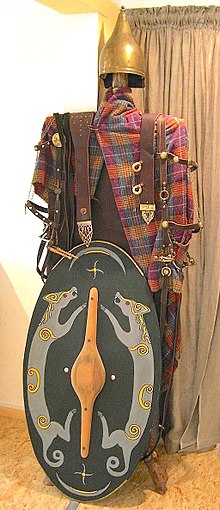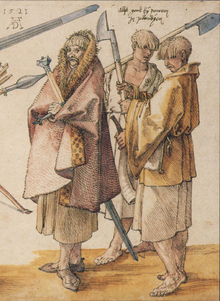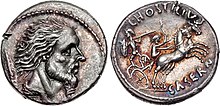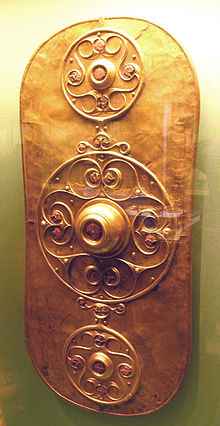Ancient Celtic warfare
While archaeological discoveries offer valuable insights into the material culture of the Celts, determining the precise nature of their ancient combat techniques remains a topic of speculation.
In the Táin Bó Cúailnge, chiefly the story of Ulaid hero Cú Chulainn, he defeats an entire army from Connacht one by one in single combat.
This story describes combat centered on the use of the spear (gae) and javelin (gá-ín) with no mention of helmets or metal armor, which is consistent and in keeping with archaeological evidence.
[2] Historical Celtic groups included the Belgae, Bituriges, Boii, Britons, Celtiberians, Gaels, Galatians, Gallaeci, Gauls, Helvetii, Lepontii, Picts, Norici and the Volcae.
It was long thought, for instance, that the Celts were headhunters, but recent research from France has indicated that it may have been the heads of slain allies that were collected to be placed in porticos, while the defeated were dumped in mass graves, their weapons ritually broken.
In the latter phases of the Hallstatt era, iron began to replace bronze in the manufacture of weapons, and the classic "Celtic sword" with its leaf-bladed design made its appearance.
[4] At the very end of the Hallstatt era, the longsword seemed to fall out of favor, ousted by shorter, thrusting daggers which are found in greater numbers among grave goods in high status burials.
Crested helmets of this period occur in greater numbers than of mail, but overall the picture is of Celtic armies being made up largely of lightly armored or unarmored fighters.
Ireland was the last region to adopt the La Tène style of Celtic culture and technology with a smaller and less dense population than that of the British or Continental Celts, the Gaelic Irish sustained an era of small scale elite clan warfare for much longer.
Kern usually fought lacking metal armor including helmets, fighting with spears (gae) and a set of javelins or darts (gá-ín), a long dagger (scian), occasionally wielding axes (tua) and bow (bogha), protected by a round shield (sciath) and in the case of higher status and class warriors, swords (claideamh).
[10] The Norman invasion in the 12th century and the ineffectiveness of traditional tactics in resisting it led to the Irish moving towards a more typically medieval style of warfare exemplified by the Gallóglaigh or Gallowglass heavy infantry soldier.
Leonnorius split off from the group with a sizable force into Thrace, heading further into Asia Minor where they ravaged the country to the shores of the Hellespont, compelled the city of Byzantium to pay them tribute, and then moved into central Anatolia.
According to Pausanias this force included large numbers of cavalry, organized in a system called Trimarcisia (from the words *tri- *marko- "three horse") dividing them into teams of three, only two of whom would be mounted at one time.
The second Brennus' expedition would have originated in Pannonia and Noricum, the same region which would later become famous for producing Noric steel, the highest quality available for armor and weaponry in the Roman Empire.
Celtic arms and armor were in fact highly advanced, as the Celts were renowned master Iron workers in the Hallstatt, La Tène cultures and in the province of Noricum.
Thus, aside from the King, Chief and wealthy nobility, body armor was rare, with most warriors wearing colorful cloaks or tunics, shirts, and pants, although some may have stripped to the waist or in some instances wore nothing at all into battle.
The Roman cavalry, composed primarily of Gallic horsemen, fought bravely and held their own against the Cataphracts but the inferiority in armor and equipment was evident and contributed to their defeat.
The Greek historian Polybius gives an account of the Battle of Telamon 225 BC in which the Romans defeated an invasion by the Boii, Insubres, Taurisci and Gaesatae.
Suffering heavy casualties, the Gaesatae either fled the battlefield or desperately charged headlong into the Roman lines where, outmatched for both numbers and equipment, they were defeated.
[34] While relatively little has been written about Celtic warfare at sea, the Gallic Veneti, a tribe dwelling on the southern coast of Armorica (Brittany), along the Gulf of Morbihan, was well known and renowned among the Gauls as a strong seafaring people.
Following the beginning of the Gallic Wars, the Veneti fiercely resisted the Romans both on land and by sea during the period following Caesar's conquest of Gaul but before his invasion of Britain.
This culminated in the Battle of Morbihan when the Romans succeeded in setting aflame and destroying the entire Gallic fleet in Quiberon Bay, with Caesar watching from the shore.
[36] Large stores of slingstones aerodynamically shaped by adding clay have been found in the Southern British hillfort of Maiden Castle[37] which indicates that slings must also have played a role in the conflicts between Celtic tribes there, probably in sieges.
The larger settlements in Gaul were described by Julius Caesar as oppida and the term is now used to designate the large pre-Roman towns that existed all across Western and Central Europe, many of which grew from hill forts.
[46] There is a correspondence in the weaponry found in graves at Schkopau and Großromstedt with the description of the Gallic society by Poseidonios, where there is a hierarchy for the warrior's companions, from the shield-bearers to the spear-bearers and finally the chief at the top.
[51] Schnippenburg's site is an interesting case of Middle La Tène influence on several aspect of the local lifestyle (fortification, adornment, weaponry, cult).
[53][57][58][59] In contrast to the scabbards found in other Germanic regions, Przeworsk culture seems to have adopted the characteristic suspension of Middle La Tène swords during the first half of the 2nd century BC.
A sword with a bronze pseudo-anthropomorphic hilt elements typical of the Middle La Tène has been discovered in the Vistula River close to the village of Siarzewo (Poland).
[65][66] Dacians incorporated Celtic long swords, round shield bosses and helmets in their panoply, a good example is the tumulus N°2 of Cugir necropolis.
During this period, both Greek and Roman writers and scholars were heavily biased against the Celts and tended to focus much on the savage ferocity of the fearless, naked, headhunting Celtic warrior, creating an image which has persisted ever since.































